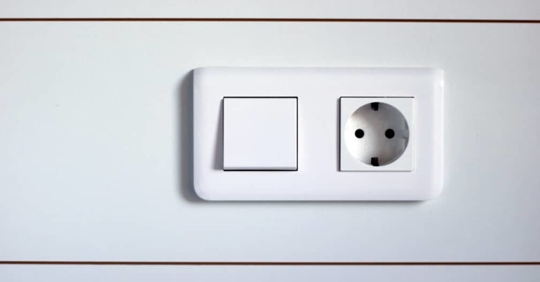Disclosure: This post contains affiliate links and I will be compensated if you make a purchase after clicking through my links. Learn More
Ever wondered why your plug doesn’t fit abroad? Different countries use different plugs.
This can be confusing, especially for travelers. Understanding the types of plugs used around the world is essential. Each country has its own standard. Some use two-pin plugs, while others use three. Voltage and frequency also vary, making it crucial to know what’s needed before you travel.
This blog will help you navigate the world of plugs. We’ll explore the different plug types and where they’re used. This will ensure you’re well-prepared for your next international trip. Stay tuned for a comprehensive guide to global plug types!
Introduction To Global Plug Types
Traveling can be exciting, but charging devices can be tricky. Different countries use different plug types. This means your devices might not fit. Understanding global plug types is essential. It ensures your gadgets stay powered. Each country has its own standard. Some even have multiple types.
Importance Of Plug Compatibility
Imagine you’re in a foreign country, ready to explore. You go to charge your phone, but it doesn’t fit. This situation is frustrating and avoidable. Plug compatibility is crucial for travelers. It prevents inconvenience and wasted time. Compatible plugs ensure your devices stay charged. This keeps you connected and stress-free.
Brief Overview Of Plug Variations
There are many plug types worldwide. Type A and B plugs are common in North America. Type C is popular in Europe and Asia. The UK uses Type G. Australia and New Zealand use Type I. Each plug type has unique prongs and voltage. Understanding these variations helps in planning. Bring the right adapter for your destination. This ensures a smooth travel experience.

Credit: wandkey.com
Type A And B Plugs
Different countries use Type A and B plugs for electrical outlets. Type A plugs have two flat parallel pins. Type B plugs include an extra grounding pin. Common in North America and Japan, these plugs fit specific voltage systems. Always check compatibility before traveling.
When traveling internationally, understanding the types of plugs used in different countries is crucial. The Type A and B plugs are two of the most common plug types you might encounter. These plugs are mainly used in North America and certain parts of Asia. Knowing which plug type is used in your destination can save you from the hassle of incompatible devices and chargers.Countries Using Type A And B
Type A and B plugs are predominantly found in the United States, Canada, Mexico, and Japan. These countries have standardized these plug types for most of their electrical outlets. If you’re planning a trip to any of these regions, carrying a Type A or B plug adapter can be a lifesaver. Don’t assume all countries in the same region use the same plug type. Japan, for example, uses Type A plugs but with a slight voltage difference. So, it’s always wise to check the specific requirements of your travel destination.Design And Usage
Type A plugs are two flat parallel pins, often ungrounded. They are lightweight and portable, making them ideal for travel. However, they lack a grounding pin, which can be a safety concern for high-power devices. Type B plugs, on the other hand, include a third round pin for grounding. This makes them safer for devices that consume more power, like laptops and hair dryers. The grounding pin provides additional stability and protection against electrical surges. Have you ever struggled with finding the right adapter while traveling? It’s a common issue that can be easily avoided with a little research. Knowing the specific plug type and voltage can make your travel experience smoother and more enjoyable. Being prepared with the correct plug type ensures your devices stay charged and ready to go. Whether you’re on a business trip or a vacation, staying connected is crucial. So, take a moment to check your destination’s plug type before you pack your bags.Type C And F Plugs
Traveling to different countries often means encountering different types of electrical plugs. Two of the most common plug types are Type C and Type F. These plugs are used in many regions around the world, ensuring compatibility with local electrical systems.
Regions With Type C And F
Type C and Type F plugs are popular across Europe. They are used in countries like Germany, France, and Spain. Parts of Asia and Africa also use these plug types. Travelers to these regions will often find these plugs in hotels and public places.
Characteristics And Applications
Type C plugs have two round prongs. They fit into most European sockets. They are often called Europlugs. Type F plugs also have two round prongs. Additionally, they have two grounding clips on the side. This provides extra safety. These plugs are known as Schuko plugs.
Type C plugs are ungrounded. They are safe for devices without metal parts. Type F plugs are grounded. They are used for devices that need extra protection. Both plug types support a voltage of 220-240V. They are suitable for small appliances, lamps, and chargers. Always check the voltage before plugging in your device.

Credit: www.lightningbugelectric.com
Type D And M Plugs
Type D plugs are common in India and South Africa. Type M plugs are used in South Africa and some other African countries.
Traveling internationally can be an exciting adventure, but it often requires some preparation, especially when it comes to powering your gadgets. Different countries use various types of electrical plugs, and among them, Type D and M plugs are quite prevalent in certain regions. Understanding where these plugs are commonly used and their unique features can save you from unexpected surprises and ensure your devices are always charged.Where Type D And M Are Common
Type D plugs are widely used in India, Nepal, and parts of Africa. If you’ve visited India, you might have noticed these plugs in almost every hotel room and household. They feature three large round pins in a triangular pattern, which might seem unusual if you’re more accustomed to flat-pin plugs. Type M plugs, on the other hand, are often found in South Africa, Swaziland, and Lesotho. They look similar to Type D but are larger and used mainly for heavier appliances. You might find them supporting high-power devices like washing machines or refrigerators. Having an adapter that fits these types is essential if you plan to travel to these regions.Unique Features
What makes the Type D plug unique is its three-pronged design, which provides a reliable connection. The round pins ensure that they fit snugly into the sockets, reducing the risk of electrical accidents. If you’re visiting a country where these are common, it’s always good to have a multi-adapter that supports this format. Type M plugs are known for their robustness. The larger size of the pins allows for a higher current to pass through, making them ideal for heavy-duty appliances. This means they can handle more power without overheating, which is crucial for safety. If you’re considering moving appliances between countries, check the plug type and voltage compatibility. Have you ever arrived in a new country only to find your devices incompatible with the local plug points? It’s a small but crucial detail that can affect your travel experience. Knowing which plug types you’ll encounter can help you prepare better, ensuring that your trip is smooth and enjoyable.Type E And K Plugs
Type E and K plugs are common in Europe and Africa. These plugs have two round pins. They fit snugly into the sockets. Countries like France, Belgium, and Poland use Type E. Denmark and Greenland prefer Type K. Travelers should carry adapters to ensure compatibility.
The world of electrical plugs can be surprisingly fascinating. Type E and K plugs are two variations you might encounter while traveling across different countries. They share similarities but also have distinct features that set them apart. Understanding these plug types not only helps you pack appropriately for your trips but also gives you insight into how countries design their electrical systems for safety and efficiency.Adoption In Various Countries
When you travel to France or Belgium, you’ll notice that Type E plugs are the standard. These plugs have two round pins and a hole for the socket’s grounding pin. The design is efficient and widely used in other European countries like Poland and Slovakia. On the other hand, Denmark uses Type K plugs. They might look similar to Type E, but they have a grounding pin that protrudes from the plug itself. This subtle difference is crucial for compatibility in Danish outlets. The question arises: why do these countries adopt slightly different plug types? It’s a reflection of historical electrical standards and safety practices. Each country has tailored its systems to best suit its infrastructure needs.Technical Specifications
Type E plugs have two round pins with a diameter of 4.8 mm. They also feature a grounding hole to ensure safe electrical connections. These plugs are rated for up to 16 amps, making them suitable for most household appliances. Type K plugs, while similar, have a grounding pin that sticks out from the plug. This pin is crucial for grounding in Danish sockets. Like Type E, Type K plugs are rated for up to 16 amps. Both plug types operate on a standard voltage of 230 V. This ensures your devices function correctly without overheating or damaging the electrical system. Imagine you’re packing for a trip to Denmark. You might assume your Type E adapter will work, but the grounding pin difference means you’ll need a Type K adapter to ensure safe operation. Understanding these technical details helps you avoid last-minute surprises. It’s always better to be prepared than to scramble for an adapter in a foreign country. Have you ever experienced the frustration of trying to plug in your charger only to realize it doesn’t fit? Knowing the technical specifics of plug types can save you from this common travel mishap. Your knowledge of Type E and K plugs will not only smooth your travels but also deepen your appreciation for the intricacies of global electrical standards.
Credit: www.reddit.com
Type G And I Plugs
Traveling to different countries can be thrilling, but it often comes with unexpected challenges. One such challenge is figuring out which plug type you’ll need for your devices. Two common plug types that might pop up on your international adventures are Type G and Type I plugs. These plugs are distinct, each with its unique design and functionality. Understanding where and how they are used can save you from the hassle of mismatched adapters and powerless gadgets.
Countries Utilizing Type G And I
Type G plugs are predominantly used in the United Kingdom, Ireland, and several other countries including Malaysia and Singapore. If you’re visiting these places, you’ll encounter a plug featuring three rectangular prongs. This design is thought to be safer, as it includes a fuse which can prevent electrical overloads.
On the other hand, Type I plugs are commonly found in Australia, New Zealand, and China. These plugs typically consist of two or three flat prongs arranged in a V-shape. They often come with an additional grounding pin, providing extra safety. Knowing this can help you plan for your next surfing trip in Australia or a business meeting in Beijing.
Functional Aspects
What makes Type G and Type I plugs unique? Type G plugs are designed to be highly secure, boasting a fuse mechanism that provides protection against electrical surges. Have you ever wondered why your phone charger didn’t blow up when there was a sudden power surge? The built-in fuse might have saved the day.
Type I plugs are versatile, often used in high-power appliances because of their robust design. The grounding pin adds an extra layer of safety, preventing electrical shocks. Imagine plugging in your laptop without worrying about safety; that’s the confidence Type I plugs can offer.
Are you prepared for your next overseas trip? Knowing the plug type used in your destination can make a significant difference. Have you ever found yourself stranded at an airport trying to charge your phone, only to realize your adapter doesn’t fit? That’s a lesson learned the hard way. As you pack for your next adventure, consider the plug type in your destination country. Your gadgets will thank you.
Adapting To Different Plug Types
Traveling to a new country can be exciting, but it brings its own set of challenges. One of the less glamorous yet crucial aspects is adapting to different plug types. Imagine landing in Paris, ready to charge your phone, only to discover your charger doesn’t fit the wall socket. This is a common scenario faced by travelers worldwide, as each country may have its own plug standard. Navigating this electrifying challenge requires some preparation and understanding.
Using Plug Adapters
Plug adapters are your best friends when it comes to using your electronics abroad. They allow you to fit your device into foreign sockets without hassle. Before you leave, check the plug type of your destination. In Europe, for instance, the Type C plug is common, whereas the UK uses Type G. Pack a universal adapter that supports multiple plug types, so you’re covered no matter where you go.
Consider buying an adapter with USB ports. This is especially handy for charging multiple devices simultaneously. Travel adapters are lightweight and easy to carry, making them a convenient addition to your luggage. But, while adapters solve connectivity, they don’t convert voltage. Ensure your device can handle the local voltage to avoid damage.
Safety Considerations
Safety should be your priority when using plug adapters. Not all adapters are created equal; some may lack essential safety features. Look for adapters with surge protection to safeguard your devices from voltage spikes. It’s a small investment for peace of mind.
Be cautious about using high-power devices like hair dryers. They can overload a plug adapter and cause overheating or even fires. If unsure, check your device’s wattage against the adapter’s capacity. It’s better to leave high-power gadgets at home or buy local alternatives.
Are you aware of the risks of using non-certified adapters? These can lead to electrical faults and potential hazards. Always choose adapters from reputable brands, and read reviews to ensure reliability. Your safety is worth the extra effort.
Adapting to different plug types is a small but essential detail in travel planning. With the right tools and knowledge, you can keep your devices powered safely and enjoy your adventures without interruptions. Have you experienced any plug-related mishaps during your travels? Share your story and tips in the comments below!
Future Trends In Plug Standardization
Countries use different plug types, leading to challenges in global standardization. Efforts are underway to harmonize plug designs. This aims to simplify travel and global electronics use.
The world is becoming more connected than ever, and with this global integration comes the need for standardized plug systems. Imagine traveling with just one adapter, regardless of your destination. This is the dream many travelers and technology enthusiasts hold. But how close are we to making this dream a reality? Let’s dive into the future trends in plug standardization and see what the future holds.Efforts For Global Compatibility
Standardizing plug systems globally is no small feat. Countries have different electrical systems and infrastructures, making a universal solution challenging. However, organizations like the International Electrotechnical Commission (IEC) are actively working towards creating guidelines for global compatibility. Imagine a world where your devices work seamlessly across borders. Efforts are underway to minimize the number of plug types worldwide. By reducing the types, manufacturers can streamline production and decrease costs. What if governments and manufacturers collaborated more closely? Such partnerships could accelerate the adoption of a universal plug. This would not only benefit travelers but also aid in reducing electronic waste.Innovations In Plug Technology
Technology is evolving, and so are electrical plugs. Some companies are developing smart plugs that can adapt to multiple plug types. These innovations could eliminate the need for bulky adapters. Imagine a plug that can adjust its voltage and shape based on the country’s requirements. This is not science fiction but a potential reality. Smart technology could make this possible, ensuring your devices are always compatible. Are we on the brink of seeing USB-C become a universal standard? With its growing popularity and versatility, USB-C is a strong contender for global standardization. Its ability to handle power and data transfer makes it a favorite among tech manufacturers. The future of plug standardization looks promising. With global efforts and technological innovations, the day may come when you pack your suitcase without worrying about plug adapters. What steps do you think are crucial for achieving this vision?Frequently Asked Questions
What Plugs Does Each Country Use?
Countries use different plug types. Type A and B are common in North America. Europe mostly uses Type C and F. The UK has Type G. Australia uses Type I. Japan uses Type A and B. Always check the specific plug type before traveling to a country.
What Does An Eu Plug Look Like?
An EU plug has two round prongs. It usually fits into European Type C, E, and F sockets.
What Adapter Do I Need For Each Country?
Check the plug type and voltage for each country. Use a universal travel adapter for multiple countries. Ensure compatibility with your devices. Research the specific adapter requirements for each destination before traveling.
What Plugs Are Used In Europe?
Europe primarily uses two plug types: Type C and Type F. Type C plugs have two round pins, while Type F plugs have two round pins with two earth clips. Both operate on 230V and 50Hz.
Conclusion
Understanding plug types worldwide helps you travel smoothly. Different countries use different plugs. Knowing this saves time and reduces stress. Always check plug types before traveling. Bring the right adapter to stay connected. This small step ensures your devices work everywhere.
Stay prepared and enjoy your journey without electrical worries. Happy travels!


